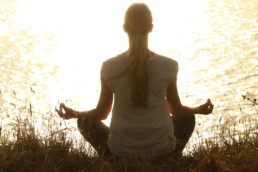
The root word pronounced “qi” or “chi” in its English form essentially means energy, life force, or energy cultivation.
Qigong has also been used as a part of martial arts to improve the skill and ability of combatants.
Sometimes, Qigong meditation is also referred to as moving meditation because the specific poses and movements used are meant to emphasize the relationship the body and breathing create with the matter and space around them.
Most techniques that channel or manipulate a person’s qi will utilize physical positions and movements, along with specific types of breathing. It is believed that Qigong meditation can result in improved mental and physical health, which is why it is popular with various kinds of fitness enthusiasts and people who are health conscious.
How is Qigong Different from Meditation?
The term meditation is very broad and it can be used for any techniques that focus on rest, peace, mindfulness, and tranquility. Almost any method of clearing someone’s thoughts for relaxation or prayer can be considered meditation.
The term meditation can be used to describe some of the things a person practicing Qigong does, but it does not address the specific goals of the discipline.
Meditation and Qigong techniques can achieve some of the same results, but Qigong is meant to restore your body’s natural balance through manipulation of energy. This can result in additional health benefits or feelings of well-being.
Proponents of the Qigong style believe that it improves overall health through things like better sleep quality and deep relaxation. Purposeful and slow breathing can help the body work more efficiently by delivering blood and oxygen to all of the limbs and individual cells.
Those who study Qigong techniques believe that this helps heal us mentally and physically by bringing balance back to the mind and body after it is disrupted by life stress.
Qigong also has three specific goals that are integrated into the practice of the art. These are related to proper posture, focused breathing from the abdominal area, and controlling the mind to enter the right state to channel your qi.
How to Prepare for Qigong Meditation
If you are interested in practicing Qigong regularly, it is helpful to do a small amount of research about common concerns and factors to consider first. This information will demonstrate how you can use your time effectively and avoid injury.
People who have specific health conditions or issues with their joints should speak with a healthcare professional before engaging in this type of exercise. There are always some risks associated with starting a new routine that puts physical strain on the body.
You should focus on your breathing and maintain an upright posture before beginning and during your Qigong session. Many proponents of Qigong practices also suggest going to your designated location immediately after getting up in the morning to receive the full benefit of meditation throughout the day.
Choosing the Best Qigong Meditation Location
As a general rule, Qigong should be practiced in a quiet location without distractions or noise.
Outdoor areas that are somewhat isolated or have little activity nearby are good choices.
There also needs to be enough open space for you to move around into various positions without being obstructed or having to make additional movements to get around obstacles or furniture.
You can think about finding an open space where you will not be interrupted and have a good range of movement.
3 Qigong Practices To Improve Meditation
-
Let go of everything else immediately before, during, and after meditation.
The proper mental state is just as important for any Qigong meditation activities as the physical movements the body makes and the pace of breathing.
Most people are now are used to checking their phones, social media accounts, taking calls, and sending out emails all day. This clearly can be very disruptive to any activity that requires focus and concentration.
Choose a time and a place where these distractions will not be available and your mind and body can truly be at peace during the duration of these Qigong techniques, as well as the times immediately before and after.
-
Warm-ups and stretches
Any kind of physical activity is assisted by getting the blood flowing and stretching the body out before beginning rather than just jumping right in.
A couple of minutes of basic cardiovascular exercise like walking or jogging, along with stretching the limbs will help put your body in the right state to optimize your time meditating and avoid injury.
-
Wearing the right clothing
Clothing used for Qigong should be loose fitting and comfortable. This does not necessarily need to be the same clothing you would use for exercise, but each person should find something that helps them breathe easily and relax. Some experimentation with a few different outfits should help you discover what works the best.
What’s Next?
About the author

